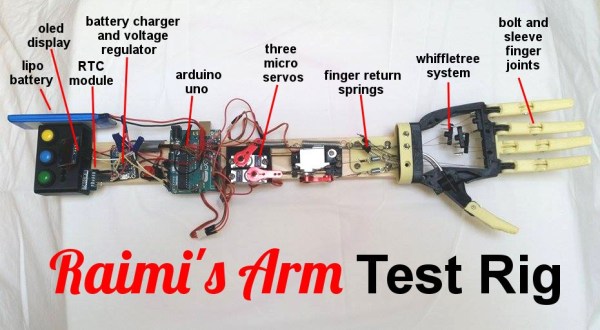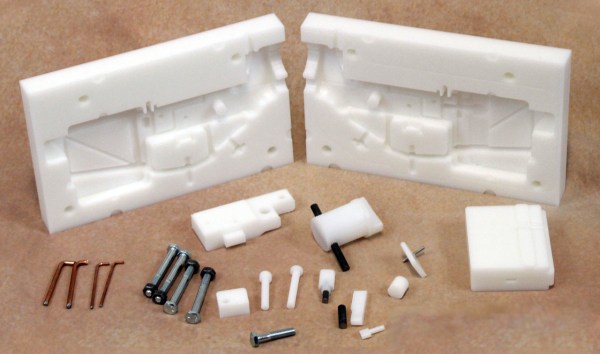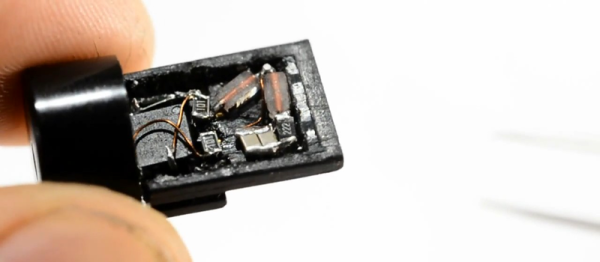Sometimes, the most amazing teams make the most wonderful things happen, and yet, there is just not enough time to finish all the features before the product ships. This is what happened to Raimi, who came to this world missing a right hand and half of her right forearm. Raimi is now 9 years old, and commercial mechatronic prostheses are still only available to those who can afford them. When Raimi’s father approached [Patrick Joyce] to ask him for help in building an affordable prosthesis, he knew it would matter, and went right to work.
Day: May 8, 2016
3D Printer Prints Sound
People like music, but they are also visual creatures. Perhaps that’s why music visualization is such a common project. Usually, you think of music visualization as using LEDs or a computer screen. However, [Gieeel] did his music visualization using a 3D printer.
Sure, the visualization is a little static compared to LEDs, but it does make an interesting conversation piece. The actual process isn’t very difficult, once you have the idea. [Gieeel] captured the waveform in Audacity, did a screen capture, and then converts the image to an SVG file using Inkscape.
From there, you can use many different CAD tools to convert the image into a 3D object. [Gieeel] used Autodesk Fusion 360 and had the resulting object professionally 3D printed.
We’ve seen other kinds of sound sculptures before. Of course, we’ve also seen a lot of traditional visualizations, as well.
Hackaday Links: It’s Mother’s Day And You Forgot
[AvE] noticed someone was having trouble with their Nepeploid Shilden Inversker, and after a sinusoidal lambda deplanarization test, noticed the dinglebop wouldn’t pass through the grumbo. [AvE] is probably just some guy who wears overalls to bed, but he does know a polyfractal magnetorestrictor when he sees one. To wit, he has a novel application of Eularian magnetronics resulting in a friction factor over unity. Game changing stuff here, from the guy who brought you the beer stein made out of an oil filter.
It was soft launched at the Midwest RepRap Festival this year, and now Lulzbot’s TAZ 6 is finally out. The biggest new feature? The electronics ‘brain box’ holds everything, including the power supply. This tower of brain box makes the Taz 6 harder to build from source, but there are unconfirmed reports that Lulzbot may sell this brainbox separately.
Boldport, and founder [Saar Drimer] are the cream of the crop when it comes to artistic PCBs. Boldport’s catalog and [Saar]’s portfolio include a tribute to [Bob Pease], a beautiful board with multicolor solder masks, and an emergency business card. Now Boldport is doing a beautiful PCB of the month club. It’s called Boldport Club, and each three-month membership gets you three months of pretty PCBs. The shop will also stop taking orders for the Boldport club 25 hours after this post goes live. If you missed the boat on the club, you can still get in on the pretty PCB action – we have the Boldport cordwood puzzle available in the Hackaday store.
The Apple IIgs was the last gasp of the Apple II before that platform was phased out for the Macintosh. Despite being mostly forgotten, except for thousands of units in middle school computer labs until the 2000s, it was a very interesting machine, with a wavetable synth, real multitasking, a GUI, and very high resolution graphics. After 30-odd years the IIgs now has quadraphonic sound. The 4soniq card was introduced at the WOzFest III conference last month, and it will give an Apple IIgs with four channels of audio output.
There’s a lot of stuff happening next weekend, and Hackaday is going to be there. If you’re at the Maker Faire Bay Area, Hackaday is taking over a pub. It’s on Saturday night, so it doesn’t conflict with the bring-a-hack at an undisclosed location on Sunday night. Me? I’m going to hamvention, mostly for the purposes of documenting the two parking lots full of swap meet. Find me and I’ll get you some Hackaday swag.
Rasberry Pi Zero Plays Every Simpsons Episode Ever At Random
If there’s a better use for Raspberry Pi Zero than a shuffler for episodes of “The Simpsons”, we haven’t heard about it.
Creator [Stephen Coyle] took inspiration from [Will Smith]’s mention of the burning need for such a device on the Tested podcast years back. The gadget is just a Zero with a familiar yellow button – hopefully it’s Pantone 116 C – that randomly selects an episode from the SD card. [Stephen] is clear on his opinion of over half of the program’s oeuvre, having found only seasons 2 through 10 worthy to load on the card. As an aside, we feel pretty old after seeing that all 593 episodes can easily fit on a 128GB SD card – we started out religiously recording every episode on VHS tapes, but had to stop after a few seasons when the collection got too big to handle.
If ripping episodes from DVDs isn’t your style, or you’re still into the first-run stuff, you might want to check out this confusingly named Smart Homer so you never miss an episode.
Continue reading “Rasberry Pi Zero Plays Every Simpsons Episode Ever At Random”
DIY Cast AR-15 Receivers Are More Interesting Than Expected
For some reason the US News media decided on the AR-15 as the poster child of guns that should not be allowed to be made for, or sold to, the consumer. The words still out on the regulation, but, in a very American response, a whole market sprang up around people saying, “Well, then we’ll just make our own AR-15.”
Ordinarily, we wouldn’t cover this sort of thing, but the work [AR-15Mold] is doing is just so dang interesting. They sell a product that enables the home user to cast an AR-15 receiver out of high performance resin. In the process they made a really informative three part video on the casting process.
A lot of people are interested in the product, and having fun with it. In this two part video series, [Liberty Marksman] cast their receivers and test them to destruction. In one video they see how many rounds they can fire out of the gun before it breaks. When it breaks, they excitedly tear down the gun to see where it failed.
It’s quite a bit of fun to watch. Videos after the break.
Continue reading “DIY Cast AR-15 Receivers Are More Interesting Than Expected”
Running A Hackerspace Is Hard: Egypt Edition
It’s no secret that it’s difficult to run a hackerspace. Different personalities, different material requirements, and often constrained spaces can require continual negotiation. But if you think that having the metalworking types getting their shavings on your electronics bench is a problem, try having your entire hackerspace demolished on short notice.
The situation in Cairo is far from normal at the moment. The building that Cairo Hackerspace had recently moved to was raided, closed for two months, and then re-opened under strict surveillance in February.
All was well until a part of the building unexpectedly collapsed. Then they got a demolition order, followed by postponement, followed by armed police entering anyway and breaking stuff, followed by a further declaration of the building as safe, and now a heritage site. And all of this over a week’s time. While some of the art studios in the Townhouse were saved, the Cairo Hackerspace’s space is gone.

The good news? Nobody got hurt in all of this, and the Cairo Hackerspace crew were able to get their gear out after the initial demolition notice. They’ve been working on a mobile hackerspace-in-a-van approach lately, so hopefully they’ll be able to keep on hacking.
So when you’re bickering over who didn’t clean up the hackspace’s coffee machine, or the proper location of your favorite soldering iron, think kindly about the Cairo crew and get back to doing what you do best — projects.
How about you? What hackerspace tales do you have? Contact us through the tips line — we’d love to hear.
Smallest MIDI Synth, Again!
Not content with fitting a tiny square-wave MIDI synthesizer into a MIDI plug, [Mitxela] went on to cram a similar noisemaker into a USB plug itself.
Besides being physically small, the code is small too, as well as the budget. It uses V-USB for the USB library running on an ATtiny85, and a couple of passive parts. His firmware (apparently) takes in MIDI notes and spits out square waves.
Continue reading “Smallest MIDI Synth, Again!”

















